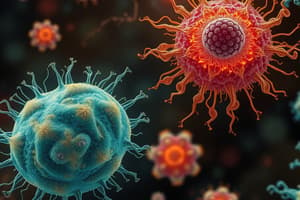Podcast
Questions and Answers
What is a distinguishing feature of eukaryotic cells compared to prokaryotic cells?
What is a distinguishing feature of eukaryotic cells compared to prokaryotic cells?
- Simple structure
- Presence of a membrane-bound nucleus (correct)
- Multiple nuclei
- Absence of organelles
Which cell type houses DNA within a double-membrane-bound structure?
Which cell type houses DNA within a double-membrane-bound structure?
- Cells of fungi
- Human cells (correct)
- Prokaryotic cells
- Archaea cells
What is the function of histones in eukaryotic cells?
What is the function of histones in eukaryotic cells?
- Package and organize DNA (correct)
- Ribosome assembly
- Cell wall formation
- Energy production
Which feature is shared by both eukaryotic and prokaryotic cells?
Which feature is shared by both eukaryotic and prokaryotic cells?
Where do eukaryotic cells contain a site for ribosome assembly?
Where do eukaryotic cells contain a site for ribosome assembly?
What is the primary source of energy for cellular processes?
What is the primary source of energy for cellular processes?
Which organelle is responsible for processing and sorting proteins and lipids?
Which organelle is responsible for processing and sorting proteins and lipids?
What is the function of peroxisomes in a cell?
What is the function of peroxisomes in a cell?
Which type of cells has a well-developed cytoskeleton composed of microtubules, intermediate filaments, and microfilaments?
Which type of cells has a well-developed cytoskeleton composed of microtubules, intermediate filaments, and microfilaments?
What is the primary difference between prokaryotic and eukaryotic cells in terms of organelles?
What is the primary difference between prokaryotic and eukaryotic cells in terms of organelles?
Flashcards are hidden until you start studying
Study Notes
Understanding Cell Structures: From Eukaryotic to Prokaryotic Cells
Introduction
The inner workings of cells, whether eukaryotic or prokaryotic, are essential for sustaining life. Eukaryotic cells, which include those of humans, plants, and fungi, possess a membrane-bound nucleus and a more complex set of organelles. On the other hand, prokaryotic cells, characteristic of bacteria and archaea, lack a membrane-bound nucleus and are simpler in structure. Both types of cells, however, share common features, such as the presence of a cell membrane and a cytoplasm.
Components of Eukaryotic Cells
Eukaryotic cells have a membrane-bound nucleus, which serves as the central hub for genetic material. Surrounded by a double membrane, the nucleus houses DNA and regulates the cell's activities. Proteins known as histones help package and organize the DNA within the nucleus. Additionally, the nucleus contains a nucleolus, a site for ribosome assembly.
Cytoplasm, the liquid portion of the cell exterior to the nucleus, contains various organelles. These membrane-bound structures play a crucial role in the cell's functionality. Among them are mitochondria, which produce ATP, the primary source of energy for cellular processes; endoplasmic reticulum (ER), where lipids and proteins are synthesized; Golgi apparatus, responsible for processing and sorting proteins and lipids; lysosomes, involved in cellular waste disposal and degradation; peroxisomes, which contain enzymes for detoxification and oxidation reactions; and vacuoles, storage compartments for nutrients and waste products.
Eukaryotic cells also showcase a well-developed cytoskeleton, a network of protein fibers that ensures cellular stability and supports cell movement. Composed of microtubules, intermediate filaments, and microfilaments, the cytoskeleton plays an integral role in maintaining cell shape and facilitating intracellular transportation.
Prokaryotic Cell Structure
Prokaryotic cells, in contrast, lack a membrane-bound nucleus. Instead, they rely on a single circular chromosome located in the nucleoid region of the cell. Prokaryotic cells have a less defined cytoplasm and fewer organelles compared to eukaryotic cells. They typically contain only one or two copies of ribosomal RNAs (rRNAs) and fewer proteins associated with translation, transcription, and other cell processes.
In terms of cytoskeleton, prokaryotic cells have a more basic structure. They contain microfilaments of actin at the poles and short microtubules that aid in cell division. Compared to eukaryotic cells, prokaryotic cells exhibit simpler organization and fewer specialized structures, reflecting their simpler lifestyle and ecological roles.
Conclusion
Both eukaryotic and prokaryotic cells display distinct structural characteristics, adapted to their respective lifestyle and cellular requirements. Despite these differences, they share common ground in the principles governing life processes, providing a foundation for our understanding of cellular dynamics.
Studying That Suits You
Use AI to generate personalized quizzes and flashcards to suit your learning preferences.




